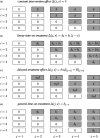Mixed-effects models for the design and analysis of stepped wedge cluster randomized trials: An overview
- PMID: 32631142
- PMCID: PMC7785651
- DOI: 10.1177/0962280220932962
Mixed-effects models for the design and analysis of stepped wedge cluster randomized trials: An overview
Abstract
The stepped wedge cluster randomized design has received increasing attention in pragmatic clinical trials and implementation science research. The key feature of the design is the unidirectional crossover of clusters from the control to intervention conditions on a staggered schedule, which induces confounding of the intervention effect by time. The stepped wedge design first appeared in the Gambia hepatitis study in the 1980s. However, the statistical model used for the design and analysis was not formally introduced until 2007 in an article by Hussey and Hughes. Since then, a variety of mixed-effects model extensions have been proposed for the design and analysis of these trials. In this article, we explore these extensions under a unified perspective. We provide a general model representation and regard various model extensions as alternative ways to characterize the secular trend, intervention effect, as well as sources of heterogeneity. We review the key model ingredients and clarify their implications for the design and analysis. The article serves as an entry point to the evolving statistical literatures on stepped wedge designs.
Keywords: Cluster randomized trials; group-randomized trials; heterogeneity; intraclass correlation coefficient; mixed-effects regression; pragmatic clinical trials; sample size calculation.
Figures



Similar articles
-
A review of current practice in the design and analysis of extremely small stepped-wedge cluster randomized trials.Clin Trials. 2025 Feb;22(1):45-56. doi: 10.1177/17407745241276137. Epub 2024 Oct 8. Clin Trials. 2025. PMID: 39377196 Free PMC article. Review.
-
Developing Statistical Methods to Improve Stepped-Wedge Cluster Randomized Trials [Internet].Washington (DC): Patient-Centered Outcomes Research Institute (PCORI); 2021 Aug. Washington (DC): Patient-Centered Outcomes Research Institute (PCORI); 2021 Aug. PMID: 38913814 Free Books & Documents. Review.
-
Optimal designs using generalized estimating equations in cluster randomized crossover and stepped wedge trials.Stat Methods Med Res. 2024 Aug;33(8):1299-1330. doi: 10.1177/09622802241247717. Epub 2024 May 30. Stat Methods Med Res. 2024. PMID: 38813761
-
Stepped wedge designs: insights from a design of experiments perspective.Stat Med. 2017 Oct 30;36(24):3772-3790. doi: 10.1002/sim.7403. Epub 2017 Aug 8. Stat Med. 2017. PMID: 28786236
-
Analysis of cluster randomised stepped wedge trials with repeated cross-sectional samples.Trials. 2017 Mar 4;18(1):101. doi: 10.1186/s13063-017-1833-7. Trials. 2017. PMID: 28259174 Free PMC article.
Cited by
-
Considerations Before Selecting a Stepped-Wedge Cluster Randomized Trial Design for a Practice Improvement Study.Ann Fam Med. 2022 May-Jun;20(3):255-261. doi: 10.1370/afm.2810. Ann Fam Med. 2022. PMID: 35606135 Free PMC article. Clinical Trial.
-
Improving the management of chronic pain, opioid use, and opioid use disorder in older adults: study protocol for I-COPE study.Trials. 2022 Jul 27;23(1):602. doi: 10.1186/s13063-022-06537-w. Trials. 2022. PMID: 35897111 Free PMC article.
-
Estimating intra-cluster correlation coefficients for planning longitudinal cluster randomized trials: a tutorial.Int J Epidemiol. 2023 Oct 5;52(5):1634-1647. doi: 10.1093/ije/dyad062. Int J Epidemiol. 2023. PMID: 37196320 Free PMC article.
-
Evaluating a whole-school approach to addressing gender-based violence in Scottish secondary schools (Equally Safe at School): a study protocol for a type I hybrid effectiveness-implementation trial.BMJ Open. 2025 Feb 16;15(2):e096596. doi: 10.1136/bmjopen-2024-096596. BMJ Open. 2025. PMID: 39956602 Free PMC article.
-
A review of current practice in the design and analysis of extremely small stepped-wedge cluster randomized trials.Clin Trials. 2025 Feb;22(1):45-56. doi: 10.1177/17407745241276137. Epub 2024 Oct 8. Clin Trials. 2025. PMID: 39377196 Free PMC article. Review.
References
-
- Murray DM. Design and analysis of group-randomized trials. New York, NY: Oxford University Press, 1998.
-
- Donner A, Klar N. Design and analysis of group-randomized trials in health research. New York, NY: Oxford University Press, 2000.
-
- Hayes RJ, Moulton LH. Cluster randomised trials. Boca Raton, FL: Taylor & Francis Group, LLC, 2009.
-
- Eldridge S, Kerry S. A practical guide to cluster randomised trials in health services research. Chichester, UK: John Wiley & Sons, 2012.
Publication types
MeSH terms
Grants and funding
LinkOut - more resources
Full Text Sources

